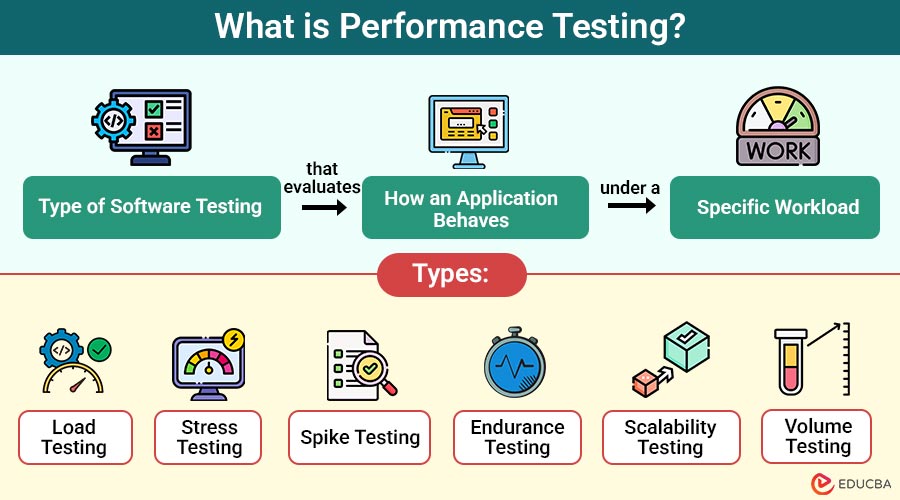

What is Performance Testing?
Performance Testing is type of software testing that evaluates how an application behaves under a specific workload. It measures critical aspects like speed, stability, and scalability to ensure the application can handle real-world usage.
- Speed – How fast does the system respond under various conditions?
- Scalability – How well does the system handle increased workload?
- Stability – Is the system stable during prolonged usage or under high stress?
Table of Contents:
Key Takeaways:
- Performance testing prevents costly failures by validating speed, stability, and scalability before real users suffer.
- Automating performance testing with real data improves accuracy, repeatability, and testing confidence across releases.
- Industry-specific performance testing ensures compliance, resilience, and seamless experience in mission-critical environments.
- Performance testing metrics help teams detect bottlenecks, optimize systems, and support business growth efficiently.
Why is Performance Testing Important?
Here are the reasons why performance testing is essential:
1. Bottlenecks Early
Helps uncover performance issues like slow queries, memory leaks, and inefficient code before they affect users significantly.
2. Ensures Speed and Scalability
Tests whether the application performs efficiently and remains responsive as user load or data volume continues to grow.
3. Improves User Satisfaction
Fast, responsive applications lead to a better user experience, increasing retention, engagement, and positive perception of your product.
4. Validates Stability
Confirms that the system can operate reliably under high stress without crashing, freezing, or producing inconsistent results.
5. Prepares for Future Growth
Enables planning and optimization for future user growth, ensuring long-term performance, reliability, and infrastructure readiness.
Types of Performance Testing
Performance testing is a broad category that includes multiple testing types. Here are the main ones:
1. Load Testing
Evaluates the system’s performance under anticipated user load. It checks response times and system stability during normal and peak usage.
2. Stress Testing
Tests the system beyond its capacity limits to identify the breaking point. It helps determine how the system recovers after failure.
3. Spike Testing
A variation of stress testing where the load is suddenly increased or decreased to observe system behavior.
4. Endurance Testing
Check system performance over an extended period to identify memory leaks, performance degradation, or resource exhaustion.
5. Scalability Testing
Assesses the application’s capacity to scale horizontally or vertically in response to increased load.
6. Volume Testing
Focuses on the impact of large volumes of data on system performance, especially database-heavy applications.
Key Performance Testing Metrics
To assess the system’s health and readiness, testers track several performance metrics:
1. Response Time
This refers to the time taken by the system to respond to a user request. It is a crucial sign of user satisfaction.
2. Throughput
Throughput measures how many requests or transactions the system can handle per second. It reflects the system’s capacity to process high loads.
3. Latency
The amount of time that passes between making a request and getting the first byte of a response is known as latency. Low latency is necessary for real-time applications.
4. Error Rate
This metric indicates the percentage of failed or erroneous requests compared to the total requests made. A high error rate suggests instability or system overload.
5. Concurrency
Concurrency represents the number of users or sessions interacting with the system simultaneously. It is essential for determining system scalability.
6. CPU and Memory Usage
These metrics monitor how much processing power and memory the system consumes under load. High usage may lead to performance degradation.
7. Bandwidth
Bandwidth measures the volume of data transferred over the network per second. Sufficient bandwidth is necessary to support large data flows without slowdowns.
Popular Performance Testing Tools
There are various tools available for performance testing based on budget, project scale, and testing needs. Here are the most popular ones:
1. Apache JMeter
- Open-source
- GUI-based
- Ideal for web and API testing
- Supports plugins and distributed testing
2. LoadRunner
- Enterprise-grade tool
- Supports wide protocols like HTTP, SAP, and Citrix
- Excellent reporting and analytics
3. Gatling
- Developer-friendly (Scala-based)
- Open-source and scriptable
- Best suited for continuous testing and CI/CD pipelines
4. k6 by Grafana
- Modern, JavaScript-based
- CLI-focused with cloud and local execution
- Designed for DevOps and automation
5. Locust
- Python-based
- Lightweight and highly scalable
- Ideal for scripting complex behavior
Performance Testing Lifecycle
A structured approach ensures meaningful and actionable performance test results.
1. Requirement Gathering
Identify key performance goals, SLAs, and user expectations to set realistic test objectives, like response time, concurrency limits, and system throughput.
2. Test Plan Creation
Outline the testing scope, select tools, define performance metrics, and list scenarios to guide testing efforts aligned with business and technical goals.
3. Scripting and Configuration
Develop test scripts simulating real user actions and configure parameters like user load, ramp-up time, and test duration based on project needs.
4. Test Execution
Execute planned performance tests in a controlled setting while continuously monitoring system behavior, infrastructure performance, and real-time resource usage metrics.
5. Result Analysis
Analyze collected data such as latency, errors, and response times to identify system weaknesses, potential bottlenecks, and root causes of failures.
6. Tuning and Optimization
Work with development teams to fix performance issues by optimizing backend logic, database queries, caching strategies, and third-party integrations.
7. Retesting and Reporting
Conduct follow-up tests after optimizations, ensuring issues are resolved, then create detailed performance reports for technical and non-technical stakeholders.
Best Practices for Performance Testing
Here are the most effective practices to ensure your performance testing yields reliable, actionable, and repeatable results:
1. Start Early
Begin performance testing during development to catch issues early, reducing cost and effort required to fix them later.
2. Use Real Data
Use production-like data and realistic usage patterns to simulate how users will interact with the application in real conditions.
3. Automate Tests
Integrate automated performance tests into your CI/CD pipeline to ensure consistent, repeatable results with every code change or deployment.
4. Baseline and Compare
Establish a performance baseline and compare results over time to detect regressions, improvements, or trends across application versions.
5. Monitor Actively
Leverage observability tools to gain real-time visibility into system metrics, helping identify root causes of performance issues effectively.
6. Monitor Actively
Simulate external services during tests to account for dependencies that impact overall performance and identify bottlenecks beyond internal systems.
Common Challenges in Performance Testing
Despite its importance, performance testing has its challenges:
1. Complex Test Setup
Use cloud-based load tools to simplify test environment creation, enabling scalable, distributed execution with less infrastructure overhead.
2. Inadequate Test Data
Create scripts or use anonymized production data to generate realistic test sets that reflect actual usage patterns and behavior.
3. Environment Mismatch
Mirror the production environment closely during testing to ensure results accurately reflect real-world system performance and conditions.
4. Unclear Benchmarks
Work with stakeholders to define clear, realistic, and measurable performance benchmarks to guide testing priorities and expectations.
5. Tool Limitations
Select tools based on specific project needs, not popularity, to ensure scalability, compatibility, and efficient test execution.
Industries that Heavily Rely on Performance Testing
Some sectors can not afford even seconds of delay. These include:
1. E-commerce
Even slight page delays cause user drop-offs and lost sales, making consistent speed and performance critical for revenue generation.
2. Banking & Finance
Transactions must process quickly and reliably to ensure user trust, prevent failures, and comply with stringent regulatory and service standards.
3. Telecom
Telecom systems must support millions of concurrent users, requiring robust performance to ensure seamless communication without lags or service drops.
4. Gaming
Real-time gameplay demands lightning-fast responses; even milliseconds of lag can ruin user experience and impact competitive multiplayer environments.
5. Media & Streaming
Smooth streaming with minimal buffering ensures audience retention; performance lapses lead to user dissatisfaction and reduced viewer engagement.
6. Healthcare
Systems must deliver high availability and accurate data retrieval, supporting critical operations where delays or errors could affect patient outcomes.
Frequently Asked Questions (FAQs)
Q1. Is performance testing only needed before deployment?
Answer: No. It should be part of continuous testing during development, staging, and post-deployment stages.
Q2. Can performance testing be automated?
Answer: Yes. Tools like Gatling, k6, and JMeter support scripting and integration with CI/CD for automation.
Q3. How many virtual users should I simulate?
Answer: It depends on expected traffic. For example, an e-commerce site might simulate 10,000 concurrent users during a sale event.
Final Thoughts
Performance testing is a non-negotiable aspect of modern software development. In a world where milliseconds can impact revenue and user satisfaction, performance testing ensures your application stays fast, reliable, and scalable under all conditions. By understanding its principles, tools, and best practices, teams can deliver products that perform as well as they function.
Recommended Articles
We hope that this EDUCBA information on “Performance Testing” was beneficial to you. You can view EDUCBA’s recommended articles for more information.
- Manual Testing
- What is Automation Testing?
- Load Testing
- JUnit Testing



